Often when I travel to a new country I have the opportunity to sample the local cuisine in some way, shape or form prior to arrival. Before heading to South Korea for the first time I had bibimbap, samgyeopsal and tteokbokki numerous times in Canada. Prior to visiting Vietnam I already had slurped countless bowls of pho in Vietnamese restaurants all over the world. But how about Kyrgyz food?
However, on our recent trip to Kyrgyzstan to cover the World Nomad Games, I arrived not knowing anything about Kyrgyz cuisine. Hence, In many ways this was refreshing.
Traditional Kyrgyz Food
Traditional Kyrgyz food is meat intensive with beef, mutton and horse meat being staples. Along with numerous types of dairy products. Cooking techniques can be traced back to the nation’s nomadic way of life.
Geographically located in the heart of Central Asia, Kyrgyzstan historically featured three major routes of the Silk Road. Furthermore, gaining influence from cuisine from nearby neighbors such as China and present day Kazakhstan.
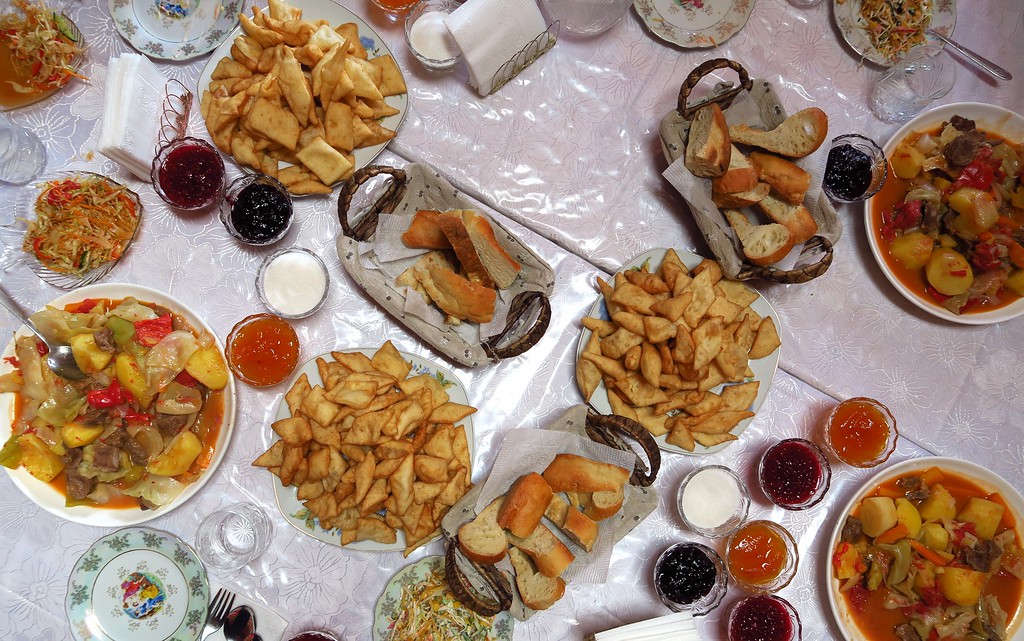
We were fortunate enough to spend a considerable amount of time gallivanting across the country visiting remote yurts in the countryside. And sampling some of the most popular dishes in restaurants in Bishkek.
The following is an introduction to traditional Kyrgyz cuisine featuring some must-try dishes.
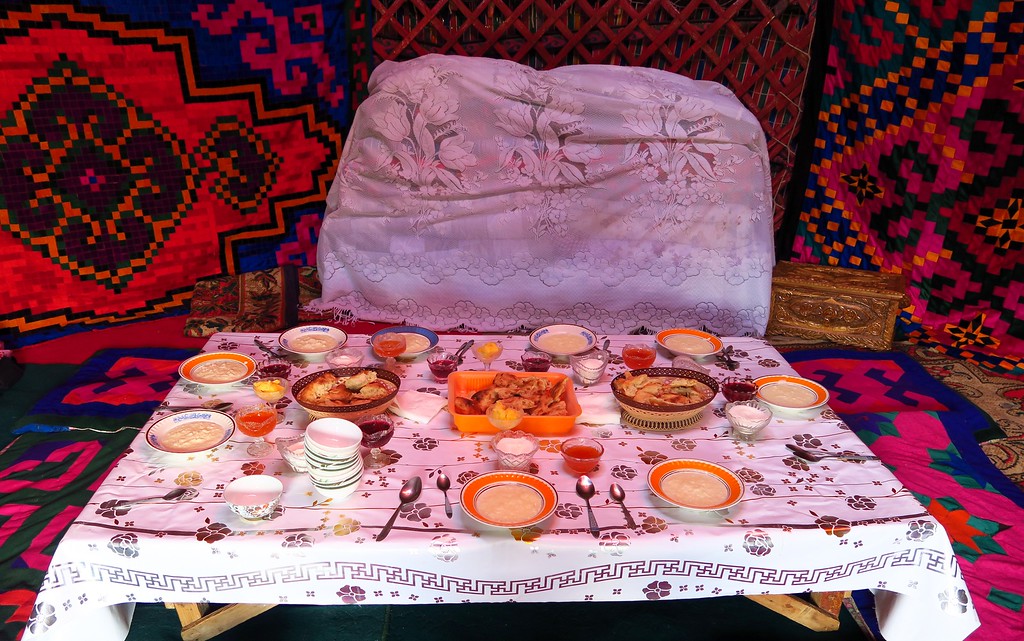
Paloo or Plov – Staple Rice Dish
Paloo (палоо) is a rice dish typically featuring garlic, chives, shredded carrots, hot peppers and various other vegetables. Along with pieces of meat (chicken, mutton, beef) fried together in a massive qazan (cast-iron cauldron).
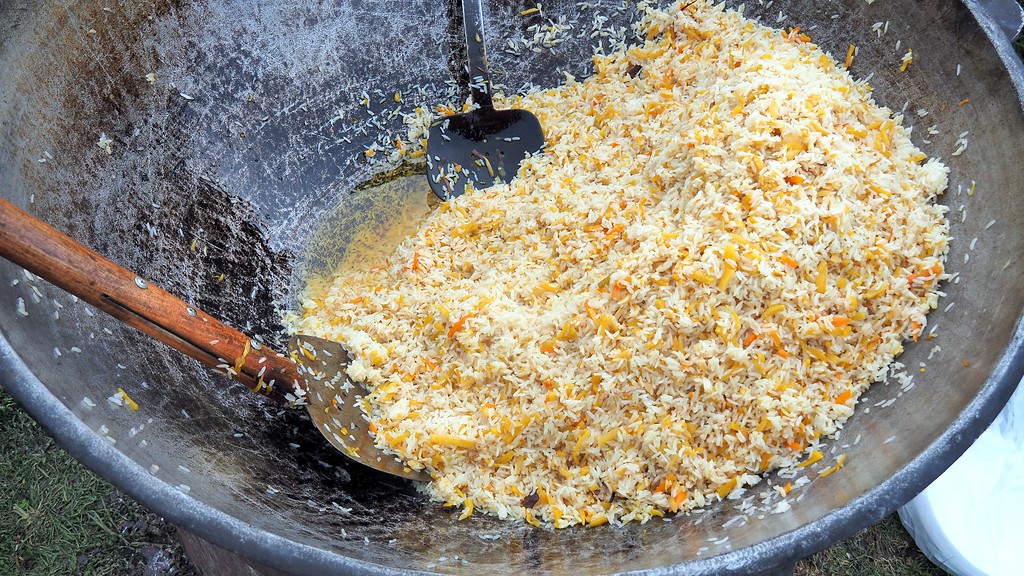
Plov, is a staple dish in Central Asian cuisine and every country in the region has its own unique way of preparing it. Fortunately, I had the opportunity to sample it numerous times. My favourite experience was having paloo. It was prepared right before my eyes during the World Nomad Games.
It was one dish I instantly fell in love with and if you’re generally a fan of Chinese-style fried rice you’ll likely find this to be amicable to your taste-buds.
Lagman – Kyrgyz Noodles
My favorite meal in Kyrgystan was Lagman (лағмон). This very popular noodle dishes can served fried or in a soup. I ate it more than any other dish during our three week stay in the country. This dish features thick noodles covered in chopped peppers and various other kinds of vegetables, all coated in a spicy vinegar-base sauce.
Considered an Uyghur dish with Chinese roots lagman is a staple dish you’ll find in most Kyrgyz restaurants. Try it in a soup and fried and let me know which one you prefer. I like both but when push comes to shove I prefer it fried.
Manti – Steamed Dumplings
The first Kyrgyz food I tried upon arrival in Bishkek was Manti (манты). These steamed dumplings can be stuffed with pumpkin, lamb, beef or potatoes, and they reminded me of Korean mandu and Tibetan momo.
They’re typically served as a side dish as opposed to being a main dish, but whenever they were in front of me I kept popping them in one after the other. If I had to recommend one kind, I’d say try the pumpkin ones.
Samsa – Kyrgyz Dumplings
Have you ever tried samosas before? If so, you’ll find Samsa, a Central Asian staple, to be quite similar. These baked pockets consist of layered pastry dough and are often stuffed with lamb, cheese, chicken, beef, potato or pumpkin.
They’re typical Kyrgyz hot street snacks at bazaars and I found myself devouring them at road-stop eateries. They were the perfect snack anytime I felt peckish in between meals.
Shashlik – Skewered Meat
If you’re a fan of grilled skewered chunks of meat Shashlik is must-try dish when visiting Kyrgyzstan. Although it can be made from chicken, beef or fish the most common kind (and one I’d recommend the most) is skewered chunks of mutton.
Sold on the street or served in restaurants it is very similar to shish kebab. One particular memory I have of eating Shashlik was with a group of friends. It tasted so good that almost all of us ended up ordering a second portion of it. Hurray for Kyrgyz food!
Kymyz – Milky Traditional Drink
You know a drink is of utmost importance to a culture when the capital city (Bishkek) of your country is named after the paddle used to churn it! Kymyz (кымыз), a slightly alcoholic drink made from fermented mare’s milk might be an acquired taste for most foreigners sampling it for the first time.
Audrey and I never quite warmed up to it but some other people traveling in our circle liked it instantly. As a fun fact, prior to fermentation mare’s milk has a whopping 40% more lactose than what you’d find in cow’s milk.
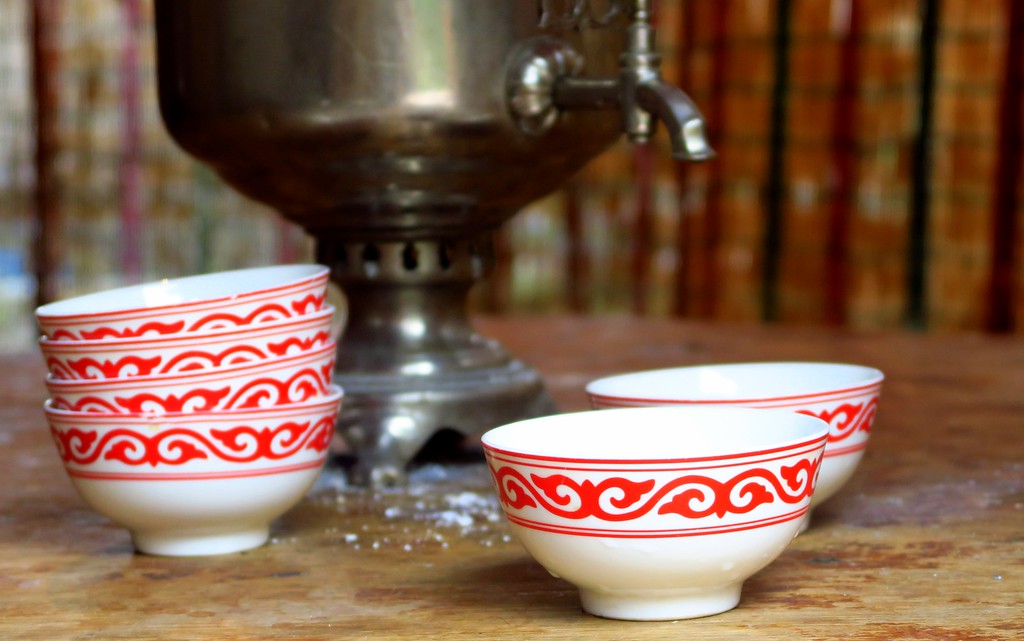
Tea with Boorsoq
One of the highlights of my trip to Kyrgyzstan was having the opportunity to eat many meals inside of a yurt, especially tea time. Boorsoq, a popular fried dough bread, is typically dipped in jams, honey or butter and served with black tea.
Kyrgyz hospitality is beyond generous and you’ll find your cup of tea being refilled constantly by an ever attentive host.
Now it is your turn. Have you tried Kyrgyz food before and/or do any of these dishes leave you intrigued to try them for the first time? Let me know in the comments section below.
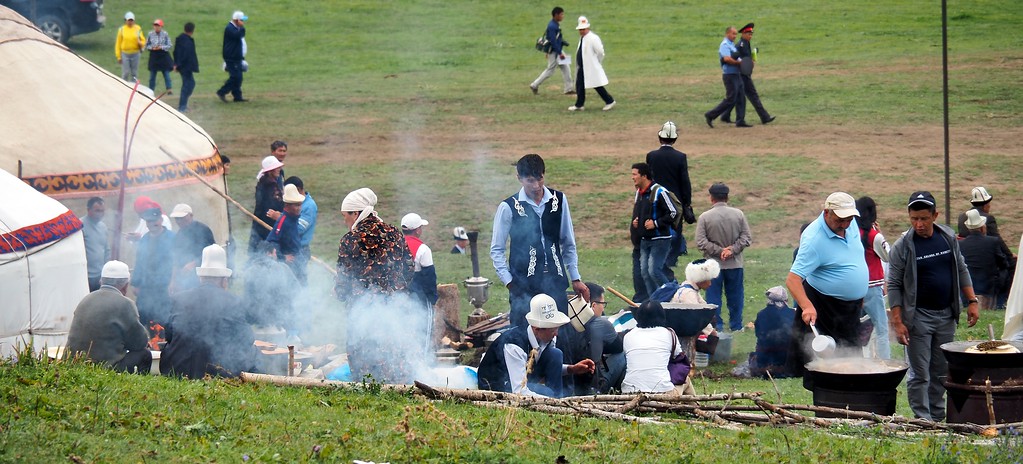
History of Kyrgyz Cuisine
Kyrgyz cuisine is a fascinating blend of ancient traditions and diverse cultural influences. Rooted in the nomadic lifestyle of the Kyrgyz people, it reflects a history of migration, trade, and interaction with neighboring cultures. This culinary heritage is characterized by hearty, flavorful dishes that showcase the simplicity and resourcefulness of a nomadic way of life.
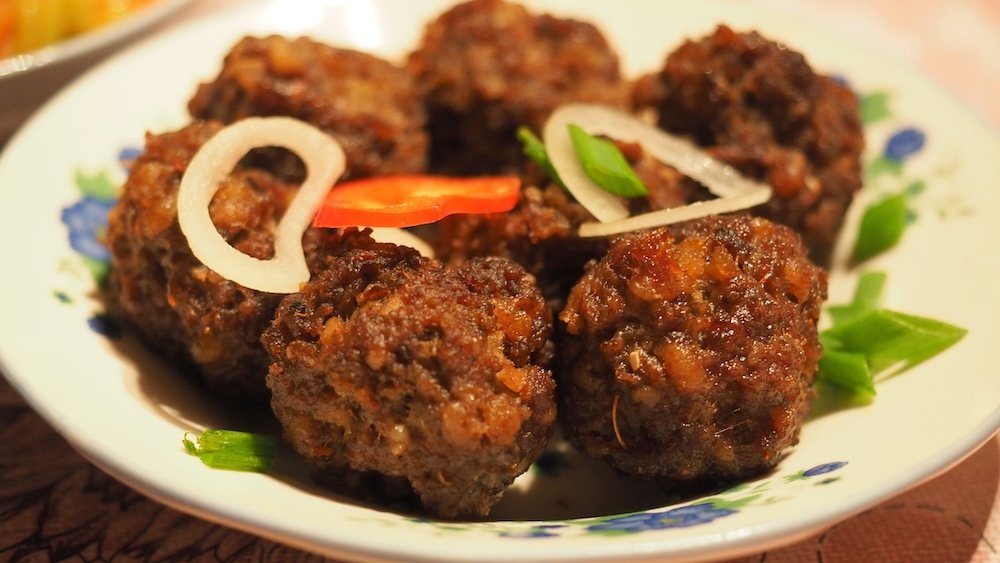
Early Nomadic Influences
Origins of Nomadic Cooking: The early Kyrgyz were nomadic herders, moving with their livestock across the vast steppes of Central Asia. This lifestyle significantly influenced their diet, which relied heavily on meat, dairy, and seasonal vegetables. The need for portable, easy-to-prepare foods led to the development of dishes that could be cooked over open fires or preserved for long journeys.
Staple Ingredients: Meat, particularly mutton and beef, has always been a staple of Kyrgyz cuisine. Horse meat, a delicacy, is often reserved for special occasions. Dairy products such as kumis (fermented mare’s milk), yogurt, and various types of cheese were essential, providing a rich source of nutrients. Grains like wheat and barley were also common, used to make bread and porridge.
Influence of the Silk Road
Culinary Exchange: The Silk Road, a network of trade routes connecting the East and West, played a crucial role in shaping Kyrgyz cuisine. Traders and travelers brought new ingredients and cooking techniques from Persia, China, India, and the Middle East. This exchange enriched the local diet with spices, fruits, and vegetables that were previously unknown in the region.
Iconic Dishes: Many of Kyrgyzstan’s iconic dishes have roots in this period of culinary exchange. For example, plov (a rice dish with meat and vegetables) shows the influence of Persian cuisine, while manty (steamed dumplings) reflect Central Asian and Chinese culinary traditions. These dishes became integral to Kyrgyz cuisine, adapted to local tastes and ingredients.
Soviet Era Transformations
Agricultural Changes: During the Soviet era, Kyrgyzstan underwent significant agricultural transformation. Collective farming and the introduction of new crops led to increased availability of ingredients like potatoes, carrots, and onions. These changes influenced traditional recipes and introduced new dishes into the Kyrgyz diet.
Urbanization and Cuisine: Urbanization brought about by Soviet policies also changed eating habits. While rural communities continued to rely on traditional foods, urban areas saw the introduction of Soviet culinary practices. Cafeterias and restaurants served a mix of Russian and Central Asian dishes, leading to a blending of culinary traditions.
Modern Kyrgyz Cuisine
Preserving Tradition: Today, Kyrgyz cuisine remains deeply connected to its nomadic roots. Traditional dishes like beshbarmak (boiled meat with noodles), shashlik (grilled meat skewers), and boorsok (fried dough) are still widely enjoyed. These dishes are often prepared for special occasions and communal feasts, preserving the cultural heritage of the Kyrgyz people.
Contemporary Influences: Contemporary Kyrgyz cuisine is also shaped by globalization and modern culinary trends. In cities like Bishkek, you’ll find a variety of international restaurants alongside traditional eateries. The fusion of old and new creates a dynamic food scene that continues to evolve while honoring its historical foundations.
Exploring Kyrgyz cuisine is not just about tasting delicious food; it’s about experiencing a culture that values tradition, community, and the joy of sharing a meal.

Complete List of Kyrgyz Foods To Try!
Kyrgyz cuisine is a feast for the senses, blending hearty flavors with a rich tapestry of cultural influences. From succulent meats and hearty stews to the refreshing taste of fermented dairy, the food of Kyrgyzstan offers something for every palate. Here’s a detailed guide to the must-try dishes that will make your culinary journey through Kyrgyzstan unforgettable.
1. Beshbarmak
- Description: Beshbarmak, the national dish of Kyrgyzstan, translates to “five fingers.” This hearty meal consists of tender boiled meat, usually mutton or beef, served over a bed of wide, flat noodles and topped with a rich broth. It’s often garnished with onions and parsley.
- Why Try It?: It’s the epitome of Kyrgyz hospitality and tradition, perfect for understanding the cultural significance of communal eating.
2. Plov
- Description: Plov is a classic rice dish made with juicy chunks of meat (beef or lamb), grated carrots, onions, and a mix of aromatic spices, including cumin and garlic. It’s often cooked in a large pot, allowing the flavors to meld together beautifully.
- Why Try It?: It’s a staple at every celebration and gathering, embodying the warmth and heartiness of Kyrgyz cuisine.
3. Manty
- Description: These steamed dumplings are filled with a savory mixture of minced meat (usually beef or lamb) and onions, seasoned with black pepper and sometimes dill. They are typically served with a dollop of sour cream or a garlic sauce.
- Why Try It?: Manty are a beloved dish, showcasing the influence of Central Asian and Chinese culinary traditions. Their delicate texture and rich filling make them a must-try.
4. Kumis
- Description: Kumis is fermented mare’s milk, slightly sour and effervescent. It has a unique taste that can be an acquired one, but it’s a fundamental part of Kyrgyz culture and diet.
- Why Try It?: Drinking kumis is a traditional experience that offers a glimpse into the nomadic lifestyle and its unique customs.
5. Shashlik
- Description: Shashlik consists of marinated pieces of meat (often lamb or beef) skewered and grilled over an open flame. The marinade usually includes vinegar, onions, and various spices, giving the meat a smoky, tangy flavor.
- Why Try It?: It’s a popular street food and a favorite at gatherings, offering a smoky, flavorful bite that’s quintessentially Kyrgyz.
6. Boorsok
- Description: These are deep-fried dough pieces, golden and crispy on the outside, with a soft interior. Often enjoyed with tea or served as a side to various dishes, they are a simple yet delightful snack.
- Why Try It?: Boorsok is a symbol of Kyrgyz hospitality, perfect for munching on while chatting with friends or family.
7. Badyan
- Description: This dish is a hearty meat and potato stew, often seasoned with a mix of local spices and herbs. It’s typically cooked slowly, allowing the flavors to develop into a rich, comforting broth.
- Why Try It?: It’s a quintessential comfort food that showcases the simplicity and heartiness of Kyrgyz cuisine.
8. Kurut
- Description: Kurut are small, dried balls of yogurt or milk, often salted and sometimes spiced. They can be eaten as a snack or added to soups for a tangy flavor.
- Why Try It?: These little treats are a staple in the Kyrgyz diet, perfect for experiencing the tangy, salty side of Kyrgyz dairy products.
9. Lagman
- Description: A dish with roots in Central Asia, Lagman features hand-pulled noodles cooked with a rich broth of meat, vegetables, and an array of spices. It’s hearty and flavorful, with a complex taste profile that’s both spicy and savory.
- Why Try It?: It’s a popular dish in many Central Asian countries, and tasting it in Kyrgyzstan offers a unique twist on this beloved noodle soup.
10. Samsa
- Description: Samsa are flaky pastries filled with spiced meat (often lamb or beef) and onions, then baked to a golden perfection. They’re a popular street food and a common treat during celebrations.
- Why Try It?: Their crispy crust and savory filling make them an irresistible snack, perfect for enjoying on the go.
11. Kurutob
- Description: Kurutob is a traditional salad made from pieces of dried bread, tomatoes, onions, and green herbs, soaked in a broth or water. It’s often served with pieces of meat or eggs and a generous drizzle of kumis.
- Why Try It?: This dish is a delightful blend of textures and flavors, perfect for cooling down on a hot day or as a hearty meal.
12. Zharkop
- Description: Zharkop is a spiced meat and potato stew, slow-cooked to perfection with onions, tomatoes, and a variety of local spices. It’s a rustic dish, embodying the essence of Kyrgyz home cooking.
- Why Try It?: Its rich, savory flavor makes it a must-try for anyone looking to experience the heart of Kyrgyz cuisine.
13. Kyrgyz Bread (Naan)
- Description: Traditional Kyrgyz bread, often baked in a tandoor oven, is soft, fluffy, and slightly chewy with a golden, crisp crust. It’s usually served alongside every meal, perfect for scooping up stews and dips.
- Why Try It?: Bread is a cornerstone of Kyrgyz cuisine, and tasting freshly baked naan is an essential part of the culinary experience.
14. Jalap
- Description: Jalap is a refreshing drink made from fermented barley or wheat, often spiced with herbs and served chilled. It’s light, slightly sour, and perfect for quenching your thirst.
- Why Try It?: This drink offers a unique taste of Kyrgyz refreshment, blending the earthy flavors of grain with a hint of herbal freshness.
15. Karakol Tea
- Description: A traditional Kyrgyz tea, often brewed with milk and flavored with salt or butter. It’s creamy, salty, and slightly sweet, reflecting the unique flavors of Kyrgyzstan’s high-altitude pastures.
- Why Try It?: This tea is a cultural staple, offering a taste of the Kyrgyz lifestyle and the rich, pastoral traditions of the region.
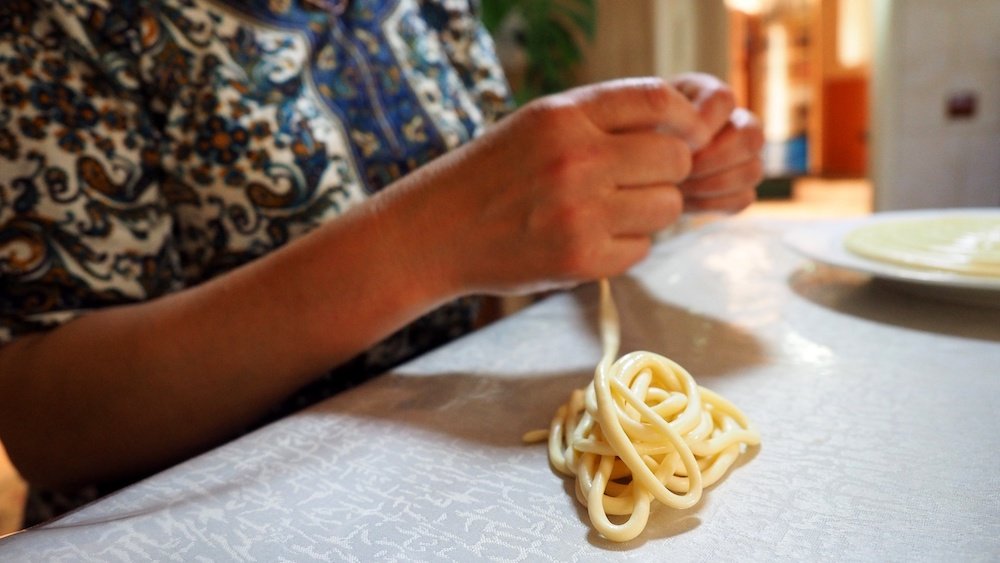
Kyrgyz Food Tours And Cooking Classes
Exploring Kyrgyz cuisine through food tours and cooking classes is an excellent way to delve into the rich culinary heritage of this Central Asian nation. From bustling markets and traditional eateries to hands-on cooking experiences, these tours and classes offer a deep dive into the flavors and techniques that define Kyrgyz food. Here’s a detailed guide to the best food tours and cooking classes in Kyrgyzstan.
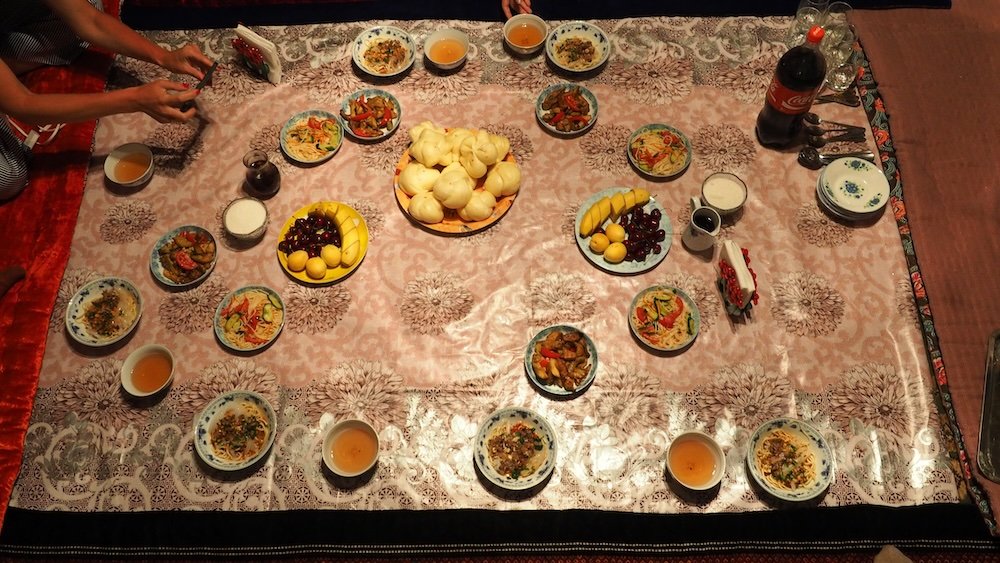
Kyrgyz Food Tours
1. Bishkek Food Tour
- Description: Discover the culinary heart of Kyrgyzstan’s capital with a guided food tour through Bishkek. This tour typically includes stops at local markets, traditional restaurants, and street food vendors.
- Highlights:
- Osh Bazaar: Explore one of the largest markets in Bishkek, where you can sample fresh produce, meats, dairy products, and spices.
- Local Restaurants: Enjoy a meal at a traditional Kyrgyz restaurant, tasting dishes like plov, beshbarmak, and shashlik.
- Street Food: Sample street food favorites such as samsa and boorsok, freshly prepared by local vendors.
- Why Try It?: This tour offers an authentic taste of Bishkek’s food scene, providing insight into the everyday culinary practices of Kyrgyz people.
2. Osh Culinary Experience
- Description: Osh, Kyrgyzstan’s second-largest city, is known for its rich culinary traditions. This food tour takes you through the city’s vibrant food markets and local eateries.
- Highlights:
- Jayma Bazaar: Visit the bustling bazaar, where you can see, smell, and taste a wide variety of local foods and ingredients.
- Traditional Dishes: Try the famous Osh plov, a unique variation of the rice dish, along with other regional specialties.
- Cultural Insights: Learn about the history and cultural significance of Osh’s culinary traditions from your knowledgeable guide.
- Why Try It?: Osh is often considered the culinary capital of Kyrgyzstan, making this tour a must for food enthusiasts looking to experience authentic Kyrgyz flavors.
3. Issyk-Kul Gastronomic Adventure
- Description: Combine stunning natural landscapes with culinary delights on this food tour around Issyk-Kul Lake. The tour includes visits to local farms, markets, and lakeside restaurants.
- Highlights:
- Farm Visits: Tour local farms and taste fresh dairy products, including kurut and kymyz.
- Lakeside Dining: Enjoy meals at picturesque lakeside restaurants, featuring fresh fish and other regional dishes.
- Cultural Immersion: Participate in traditional Kyrgyz tea ceremonies and learn about local food customs.
- Why Try It?: This tour offers a unique blend of natural beauty and culinary exploration, perfect for those looking to experience Kyrgyzstan’s diverse food landscape.

Kyrgyz Cooking Classes
1. Bishkek Cooking Class
- Description: Learn to cook traditional Kyrgyz dishes in a hands-on cooking class in Bishkek. Led by experienced local chefs, these classes provide an in-depth look at Kyrgyz culinary techniques and ingredients.
- Highlights:
- Beshbarmak Preparation: Master the art of making beshbarmak, from boiling the meat to preparing the noodles and broth.
- Manty Making: Learn how to make manty from scratch, including preparing the dough, filling, and steaming process.
- Kyrgyz Salads: Discover how to create fresh and flavorful Kyrgyz salads using local vegetables and herbs.
- Why Try It?: This class offers a comprehensive introduction to Kyrgyz cooking, providing practical skills and delicious recipes to take home.
2. Osh Cooking Workshop
- Description: Dive into the culinary traditions of Osh with a hands-on cooking workshop. This class is perfect for those looking to explore regional specialties and traditional cooking methods.
- Highlights:
- Plov Cooking: Learn the secrets of making the perfect Osh plov, including selecting the right ingredients and cooking techniques.
- Samsa Baking: Master the art of baking samsa, from preparing the dough to creating the flavorful filling.
- Cultural Exchange: Engage with local chefs and fellow participants, sharing stories and culinary tips.
- Why Try It?: This workshop offers an immersive experience in Osh’s unique culinary heritage, allowing you to recreate authentic dishes at home.
3. Issyk-Kul Cooking Experience
- Description: Enhance your visit to Issyk-Kul with a cooking class that combines local ingredients and traditional recipes. Held at lakeside locations or local homes, these classes offer a scenic and intimate cooking experience.
- Highlights:
- Traditional Bread Making: Learn to bake traditional Kyrgyz bread in a tandoor oven.
- Lagman Noodles: Discover how to make lagman noodles by hand, along with the rich, flavorful broth.
- Dairy Delights: Prepare and taste various dairy products, such as kurut and kymyz, integral to Kyrgyz cuisine.
- Why Try It?: This class offers a unique opportunity to cook with local ingredients in a beautiful setting, making for a memorable culinary adventure.
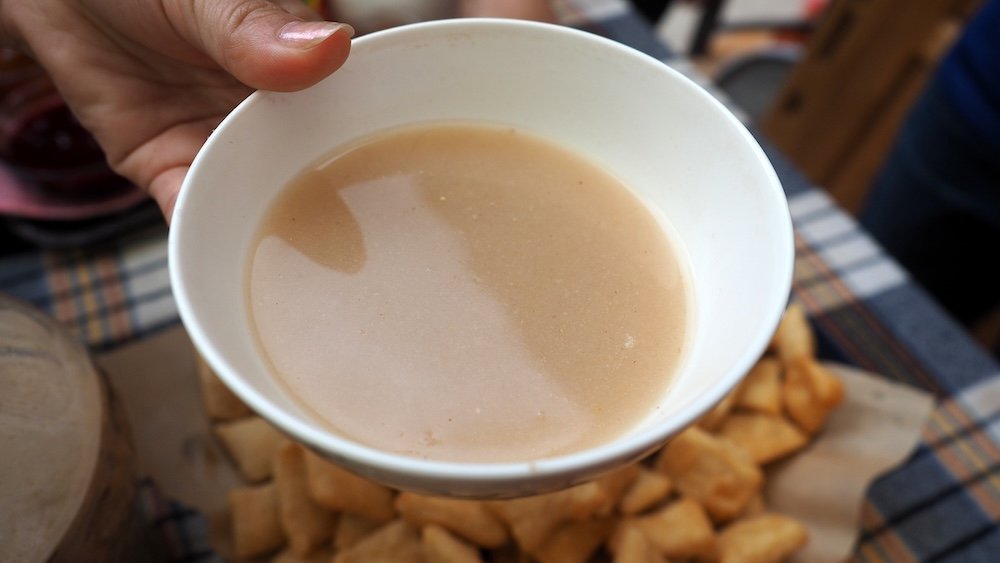
How to Arrange Your Culinary Experience
1. Booking Tours and Classes
- Online Reservations: Most food tours and cooking classes can be booked online through official websites or travel platforms like Viator and TripAdvisor.
- Local Recommendations: Ask for recommendations from your hotel or local tourism office. They often have connections with reputable tour operators and cooking schools.
2. Preparing for Your Experience
- Dress Comfortably: Wear comfortable clothing and shoes, especially for food tours that involve a lot of walking.
- Bring Essentials: Carry a notebook for jotting down recipes and tips, a camera for capturing memories, and a reusable water bottle to stay hydrated.
3. Customizing Your Experience
- Dietary Preferences: Inform the tour or class organizer of any dietary restrictions or preferences ahead of time. Many can accommodate vegetarians, vegans, and other dietary needs.
- Private Tours: Consider booking a private tour or class for a more personalized experience, allowing for flexibility in the schedule and focus on your interests.
Whether you’re sampling street food in Bishkek, making plov in Osh, or baking bread by Issyk-Kul, each bite and each dish tells a story of a rich, vibrant culture. Enjoy your culinary journey in Kyrgyzstan!

Tips for Experiencing Kyrgyz Food Firsthand
Local Markets:
Stepping into Kyrgyzstan’s local markets provides an authentic immersion into the nation’s culinary heart. These ‘bazars’ are a mélange of sights, sounds, and scents, presenting a vibrant tapestry of the nation’s food culture.
- Osh Bazaar in Bishkek: Located in the capital city, Osh Bazaar is an expansive marketplace that acts as a culinary compass for visitors. You can witness a plethora of fresh produce ranging from juicy melons in summer to hearty root vegetables in winter. National delicacies, such as ‘kurut’, are available in abundance. Stallholders might even offer a taste. The market also has a vast array of spices, essential for Kyrgyz cooking. The fresh bread section is a treat to the senses, with the aroma of ‘tandoor nan’ being baked filling the air.
- Navigating the Markets: While exciting, the sprawling nature of these bazars can be daunting. To ensure a holistic experience, consider visiting in the early morning when the produce is freshest and crowds are thinner. If possible, accompanying a local will provide a richer understanding, guiding you through the intricate lanes and introducing you to hidden gems.
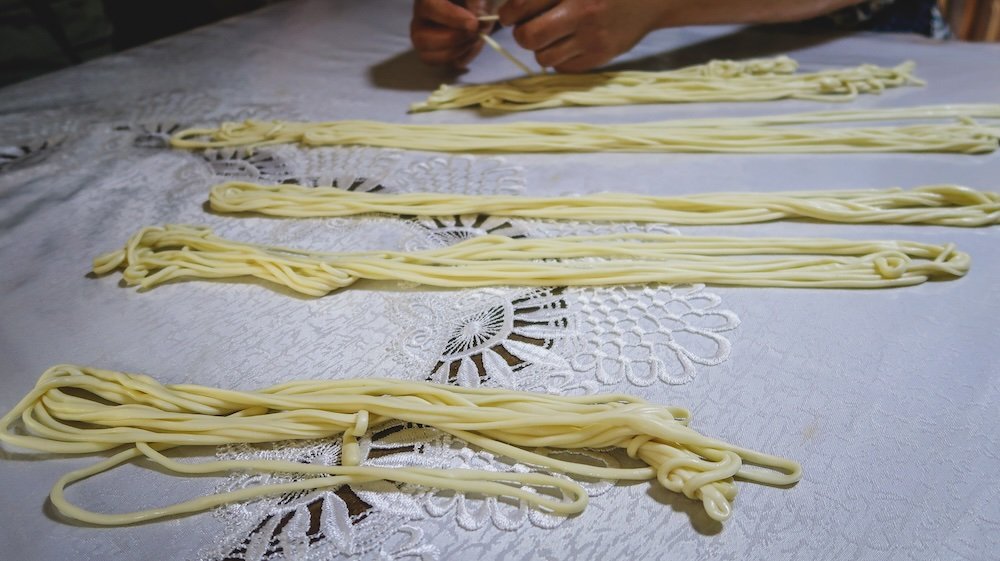
Traditional Dining:
To truly understand Kyrgyz cuisine, one must delve deep into its communal dining culture. Meals are not merely sustenance; they are cherished moments of shared joy.
- Dastarkhan: Central to Kyrgyz dining is the concept of ‘Dastarkhan’. A large cloth or mat spread either on a table or directly on the ground acts as the serving space. The arrangement signifies unity, hospitality, and the shared joy of a meal. Dishes are placed centrally, allowing everyone to partake.
- Beshbarmak Ceremony: This dish, whose name translates to ‘five fingers’, due to its traditional consumption using hands, is a testament to Kyrgyz hospitality. As a guest, being invited to such a feast is an honor. Special attention is given to elders, reflecting the society’s respect for age and wisdom.
Festivals and Celebrations:
Kyrgyzstan’s vibrant festival scene offers a delightful culinary journey, presenting traditional dishes crafted for celebration.
- Nowruz: Marking the advent of spring, Nowruz is a time of renewal. Culinary delights like ‘sumolok’, a sweet porridge made from germinated wheat grains, dominate the tables. Communities often come together, sharing meals and rejoicing in the season’s freshness.
- Horse Festivals: Given the intrinsic link between the Kyrgyz people and their equestrian heritage, horse festivals are prominent. Here, amidst the excitement of horse races and games, one can sample ‘kumys’, a drink that showcases the deep-rooted bond between the Kyrgyz and their horses.

Etiquette:
When delving into Kyrgyz culinary experiences, understanding and respecting local etiquette is crucial.
- Greetings: A warm handshake often accompanies greetings. When invited into a home, it’s traditional and courteous to bring along a small gift, like fruits or sweets, as a token of appreciation.
- Sitting Posture: If the setting is traditional, you might find yourself seated on the floor. Ensure your feet aren’t directed towards the food or individuals. It’s best to sit cross-legged.
- Eating: Kyrgyz dining places immense respect on elders. It’s customary to wait for the eldest member to initiate the meal. If presented with a dish, even if unfamiliar, it’s polite to at least sample it, showcasing your appreciation for the host’s effort.
- Tipping: In cities, as global customs seep in, tipping is becoming more prevalent. While not obligatory in more traditional eateries or homes, in urban restaurants, a tip of 10-15% signals appreciation for the service.
Eating Your Way Around Kyrgyzstan: Where To Start
If you’re planning a trip and want to build your itinerary around food (no judgement here), it helps to think in three hubs:
- Bishkek – gateway city, easy first taste of everything.
- Karakol / Issyk-Kul – markets, Dungan food, village and yurt meals.
- Osh and the south – big flavours, legendary plov, proper bazaar chaos.
From there, you can layer on yurts, homestays, markets and maybe a cooking class or two.
Bishkek For Food Lovers
Bishkek is where you get your bearings. It’s also where you realise just how cheap and generous Kyrgyz portions can be.
Types Of Places You’ll Be Eating In Bishkek
You’ll see a few common styles of eateries around the capital:
- Stolovaya (canteens)
Self-service, trays in hand, steam tables full of stews, salads and sides. Great for a quick, cheap, local lunch. - Chaikhana (tea houses)
Low tables, cushions, endless tea refills, big plates of plov and shashlik. This is where you settle in and stay a while. - Lagman & manty cafés
Small neighbourhood spots with hand-written menus and a laser focus on noodles and dumplings. - Modern cafés and bakeries
A bit hipster, good coffee, wi-fi, and pastries if you’ve temporarily hit your dough-and-meat limit.
A One-Day Food Itinerary In Bishkek
If you only had one full day in Bishkek and wanted to eat like you mean it, you could do something like this:
| Time | What To Eat | Where To Aim For | Why It Works |
|---|---|---|---|
| 08:00–09:00 | Tea & boorsoq / bread | Local bakery or café near your guesthouse | Ease into things with something simple |
| 10:00–12:00 | Market snacks & kurut | Osh Bazaar | Taste as you wander, pick up picnic stuff |
| 13:00–14:30 | Plov or beshbarmak | A traditional chaikhana | First big, proper Kyrgyz meal |
| 16:00–17:00 | Coffee & sweet pastry | Central café (near Ala-Too Square) | People-watching and digestion break |
| 19:00–21:00 | Lagman & manty + tea | Neighbourhood noodle place | Noodles, dumplings, round two of heaven |
You can shuffle things around, but that basic rhythm of “light start – market grazing – heavy lunch – walk it off – noodle dinner” is hard to beat.
How Much You’ll Pay In Bishkek (Roughly)
Prices move with inflation and where you go, but ballpark:
- Simple café breakfast (tea + bread + jam): $2–4
- Big plate of plov / lagman in a local place: $3–6
- Heavier sit-down meal with salads, meat, bread, drinks for two: $12–20
If you avoid the most tourist-friendly spots and stick to places where the menu is mostly in Kyrgyz/Russian, you’ll eat very well on a pretty modest budget.
Karakol, Issyk-Kul And Village Food
Once you leave the capital, the food experience shifts from “menu ordering” to “you’re eating what the family’s eating tonight” – which, honestly, is when things get really good.
Karakol: Bowls Of Noodles And Backyard Tables
Karakol is a sleepy little town with some surprisingly big flavours.
Expect to find:
- Lagman in all its forms – fried, soupy, spicy, mild.
- Dungan food – big communal dishes, piles of herbs, plenty of chilli if you want it.
- Homemade jams and breads – especially at guesthouses and homestays.
Meals here have that “cooked by someone’s auntie” feel. Don’t be surprised if you’re ushered into a backyard, seated at a plastic table, and presented with more dishes than you thought you ordered.
What To Expect Eating In A Yurt
At some point you’ll end up in a yurt camp – maybe at a “luxury” camp with proper beds, maybe in a more rustic setup near a pasture or lake. Food in yurts is half of the experience.
Typical Yurt Meal Flow
- Warm welcome & tea
The moment you step in, the teapot appears. Expect black or green tea, sometimes with milk, often with jam and boorsoq. - Cold plates and bread first
Think salads, pickles, sliced tomatoes and cucumbers, cheese, jams and honey, always with a big basket of bread. - Hearty mains
Stews, plov, lagman, sometimes grilled meat. On special occasions you might get horse meat dishes. - Sweets and more tea
Biscuits, candies, dried fruits, more jam, more tea, more gentle insistence that you haven’t eaten enough yet.
Do’s And Don’ts At Yurt Meals
- Do take small portions at first – the food keeps coming.
- Do compliment the cook; a simple “очень вкусно” (ochen’ vkusno – very tasty) goes a long way.
- Do accept at least a sip of whatever traditional drink is offered, even if you’re not sure you’ll love it.
- Don’t finish every dish to the last crumb – a little left over on the table often signals that the host has provided abundantly.
- Don’t stress if you don’t know the etiquette perfectly; people are usually just happy you’re curious and willing to try.
Osh And The South: Plov Country
Osh has a reputation for food that even Bishkek locals will nod approvingly about. It’s warmer, a bit rougher around the edges, and the plates of rice are serious business.
Market Meals In Osh
Around the main bazaar you can:
- Watch gigantic cauldrons of plov being stirred with paddles that look like oars.
- Snack your way through samsa stalls, each baker swearing theirs is the best.
- Try different breads – some thick and fluffy, others thin and crisp – all stamped with patterns before they’re baked.
If you love markets, Osh is one of those places where you can lose hours wandering around with a bag full of snacks and a camera battery that empties way too quickly.
Surviving (And Enjoying) Kyrgyz Food As A Vegetarian Or Flexitarian
Let’s be honest: Kyrgyz cuisine is built around meat and dairy. But that doesn’t mean you’re doomed to live on plain bread if you don’t eat meat.
Vegetarian-Friendly Staples
You can usually find:
- Pumpkin manty – sweet-savory, steamed dumplings, properly filling.
- Potato samsa – flaky pastries with potato and sometimes onion.
- Lagman “bez myasa” – noodles with vegetables only.
- Salads – simple tomato-cucumber-onion deals, plus variations with cabbage, beets or beans.
- Boorsoq and bread – dangerously moreish, especially with jam and honey.
Dairy is everywhere, so if you’re vegan you’re playing on hard mode, but still not impossible with some planning.
Useful Phrases When Ordering
You don’t have to become fluent overnight, but a couple of phrases help a lot:
- “Я не ем мясо” – Ya ne yem myaso – “I don’t eat meat.”
- “Можно без мяса?” – Mozhno bez myasa? – “Can I have it without meat?”
- “У вас есть блюда без мясa?” – U vas yest blyuda bez myasa? – “Do you have dishes without meat?”
People might still sneak in a bit of broth or sprinkle of meat, but most will at least understand that you’re trying to avoid big chunks.
How Kyrgyz Meals Actually Feel At The Table
One thing I loved about eating my way across Kyrgyzstan is that meals rarely felt rushed. Even the quick ones somehow turned into a slow tea session.
The Order Of Things
A typical sit-down meal often goes like this:
- Tea first – almost always.
- Bread and small dishes – fresh bread, boorsoq, jams, honey, salads.
- Soups or mains – lagman, shorpo (broth with meat and potatoes), plov, beshbarmak.
- More tea & sweets – candies, cookies, dried fruits.
If you’re used to Western “starter–main–dessert” structure, this feels looser and more communal. Dishes land on the table, people reach in, share, talk, reach in again.
Hands, Cutlery And Sharing
- At home and in yurts, eating with your hands (especially with beshbarmak) is still normal and expected.
- In restaurants, you’ll mostly use forks and spoons, with knives showing up less often.
- Big plates are meant to be shared. Ordering “family style” with friends gives you the chance to try way more dishes without rolling out of the place.
What Kyrgyz Food Costs: Building A Daily Budget
Here’s a very rough guide to food costs to help you sketch out a realistic budget:
| Type Of Meal | What It Might Include | Approx. Cost (USD) |
|---|---|---|
| Simple breakfast | Tea, bread, eggs or porridge | $2–4 |
| Market snacking | Samsa, boorsoq, fruit, a drink | $1–3 per stop |
| Local lunch in a stolovaya | Soup + main (plov/lagman) + bread | $3–6 |
| Café lunch with coffee | Main dish + coffee / soft drink | $5–10 |
| Big dinner in a traditional restaurant | Shared salads, meat dish, bread, tea (2 people) | $12–25 total |
| “Splurge” dinner in a nicer place | Multiple courses, maybe wine | $20–35 per person |
If you’re mostly eating at local places and markets, $10–15 per day on food is entirely doable. If you like cafés and the occasional fancy dinner, $20–25 per day is still comfortable.
Immersing oneself in Kyrgyzstan’s culinary world is not merely about tasting food; it’s about understanding a culture, a history, and a way of life that celebrates community, hospitality, and the sheer joy of sharing.
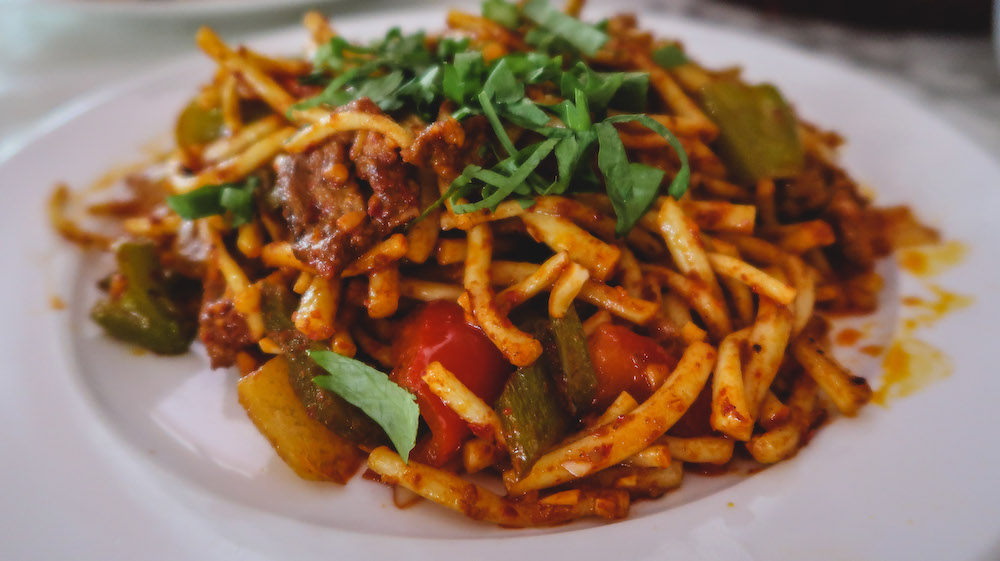
Essential Questions About Eating in Kyrgyzstan: Food, Logistics & Local Tips 🇰🇬
What are the must-try traditional dishes in Kyrgyzstan — and which should I sample first?
Absolutely. There are a handful of dishes that really showcase Kyrgyz cuisine and should be on your “first meal” list:
Beshbarmak (boiled meat, usually lamb or beef, over wide noodles) is the national classic and often served for guests. Plov (or paloo) is a hearty rice-and-meat dish cooked in a big cauldron, rich with carrots, onions and garlic. Lagman is your go-to noodle comfort food, either fried or in soup, with vegetables and sometimes meat. Then you’ve got snack heroes: manti and samsa (dumplings and stuffed pastries), plus shashlik (grilled meat skewers) for barbecue fans. If you’re feeling adventurous, sip a little kumis (fermented mare’s milk) for a very local, very memorable taste of Kyrgyz life.
When is the best time of year to visit Kyrgyzstan if I want to enjoy local food and outdoor culture?
It depends. If you want the full “yurts, mountains, markets and big plates of plov” experience, your sweet spot is roughly May to September. That’s when mountain passes are open, yurt camps are running and it’s easy to move between regions. Spring and autumn are great if you prefer cooler temperatures and fewer people, and you’ll still eat incredibly well. Deep winter is beautiful but more hardcore: some roads close, tours and homestays wind down and you’ll be sticking mostly to cities and larger towns.
Is it possible to eat well in Kyrgyzstan on a tight budget? How much should I expect to spend on food?
Yes. Kyrgyzstan is still one of those places where you can eat properly without torching your budget. At the most basic level, you can get a simple café breakfast (tea, bread, jam, maybe eggs) for just a few dollars. A generous plate of lagman or plov at a local canteen usually sits in the low single digits in US dollars. If two people go out for a “we’re hungry” dinner in a local place — salads, meat dish, bread, tea — you’re still typically under what you’d pay for a single main in many Western cities. If you stick to local spots and markets, 10–15 USD per person per day on food is realistic, and even 20–25 USD feels quite comfortable with the occasional café or nicer restaurant thrown in.
I’m vegetarian or mostly plant-based. Is Kyrgyz cuisine still an option for me?
Yes — with some strategy. Kyrgyz food is heavily built around meat and dairy, but there are options. Look for pumpkin or potato manti, potato samsa, veggie lagman (you can ask for it “without meat”), simple soups, tomato-cucumber salads, cabbage or beet salads, and of course endless bread and boorsoq with jam or honey. In Bishkek and other larger towns, you’ll often find cafés that can put together something meat-free without much fuss. It becomes trickier in remote villages and yurt camps, where a lot of dishes are prepped in meat stock or served family-style, but if you warn hosts in advance and stay flexible, you can usually get by.
Are there any cultural or dining etiquettes in Kyrgyzstan I should know before eating with locals or in a yurt?
Definitely. Kyrgyz meals are as much about hospitality as they are about food. If you’re invited into a home or yurt, it’s polite to accept at least a small taste of whatever’s offered — refusing everything can feel rude. In more traditional settings, people might sit on the floor around a low table; try not to point your feet toward the food or other people. Often the eldest person or host will start the meal, so it’s good manners to wait a moment before diving in. Dishes are shared, and you’re encouraged to take more, but you don’t have to clear every plate — leaving a little can signal that your host has provided abundantly. And if beshbarmak or other dishes are eaten with hands, just go with it; it’s part of the fun.
How safe is it to travel and eat around Kyrgyzstan, especially in cities and bazaars?
Generally, yes — it feels safe, especially for travellers used to big-city chaos elsewhere. In Bishkek, Osh and other larger places, the main issue is the usual big-city stuff: pickpocketing or opportunistic theft in crowded markets, on marshrutkas (minibuses), or around bus stations. I keep my valuables close, don’t flash big wads of cash, and stay aware in busy bazaar areas. Street food is common and usually fine, but if you have a sensitive stomach, aim for stalls with a steady flow of locals, and be a little cautious with lukewarm meats in the hottest months.
If I travel with kids or someone who doesn’t like very heavy or unfamiliar food, will Kyrgyz food still work?
Absolutely. You can keep it simple: bread with jam or honey, soups with potatoes and carrots, plain rice, grilled chicken, potato samsa, boiled potatoes and fresh salads are usually easy wins with picky eaters. Lagman without too much spice is basically a big bowl of noodles and veggies — rarely a hard sell. In yurt camps or homestays, hosts are often happy to tone down spices, avoid strange cuts and serve “gentler” dishes if you ask ahead. Bring a few comfort snacks from home just in case, but most families I’ve met found Kyrgyz food hearty, filling and surprisingly kid-friendly once they’d tried it.
What if I want a more Western-style meal once in a while — is that possible, or will I be stuck with heavy meat dishes?
Nope, you’re not stuck. In the capital and bigger towns you’ll find modern cafés, bakeries and restaurants with things like omelettes, pancakes, burgers, sandwiches, pizza, salads and decent coffee. Prices run higher than at local canteens, but they’re still reasonable by many Western standards. Once you move into smaller towns and villages, it’s much more about traditional Kyrgyz and Central Asian fare, so if you know you’ll miss certain foods, enjoy your “Western break” in Bishkek or Karakol before heading out.
When visiting rural areas or staying in a yurt, what should I know about how meals are served?
Think “slow feast” rather than quick in-and-out. When you arrive at a yurt, you’re usually sat down with tea almost immediately, plus bread, boorsoq, jams, honey and small plates of pickles or salads. Then come the main dishes: maybe plov, lagman, stews, grilled meats or something special like horse meat on big occasions. After that, there’s more tea, sweets, biscuits and dried fruits. Portions are generous and shared, so it’s smart to start with smaller servings — food will keep appearing. Complimenting the cooking (“very tasty!”) is always appreciated, and even if you’re full, taking a tiny extra bite can feel more polite than stopping dead.
How can I manage as a traveller with dietary restrictions like gluten-free, lactose intolerance or specific allergies?
Honestly, this is where you need to plan ahead. Gluten-free is tough because bread and noodles are everywhere, and cross-contamination is almost guaranteed. You can still focus on plain meat, potatoes, salads and some grilled dishes, but communication can be a challenge. Lactose intolerance is slightly easier to navigate if you avoid obvious dairy like kumis, yogurt, cream and cheese, but some dishes are cooked with butter or milk, so again, explain if you can. For serious allergies (nuts, shellfish, etc.), carry a written card in Russian explaining clearly what you can’t eat, and err on the cautious side, especially in very local places where recipes aren’t written down and substitutions aren’t common.
Do locals drink alcohol or mostly stick to tea and traditional drinks?
Both. Tea is king — black or green, with or without milk — and it’s poured all day long. But alcohol is definitely present, especially vodka and beer in cities and at celebrations. Then you have kumis (fermented mare’s milk), which has a low alcohol content but strong cultural weight. If you’re offered kumis and you’re curious, start with a small glass; some travellers fall in love with it, others never quite get there. Declining alcohol is usually fine if you’re polite and clear about it, and tea is almost always an acceptable alternative.
Can I rely on cards and ATMs when eating out, or should I always have cash on me?
Cash wins. In Bishkek and Osh, mid-range restaurants, cafés and supermarkets often accept cards, but smaller eateries, markets, street stalls and rural guesthouses almost always prefer cash. ATMs are easy to find in bigger towns, much less so once you head into remote valleys or around less-visited parts of Issyk-Kul. I like to withdraw enough cash in major hubs to comfortably cover a few days of meals, snacks and small purchases, then top up whenever I’m back in a city.
Overall, Kyrgyzstan offers a rich and diverse culinary scene that is worth exploring. From hearty meat dishes to refreshing dairy-based drinks, there is something to satisfy every taste bud. Don’t hesitate to indulge in the delicious and traditional food of Kyrgyzstan during your visit!
This trip was made possible with the support of Discover Kyrgyzstan and USAID. As always, all opinions expressed here are my own.




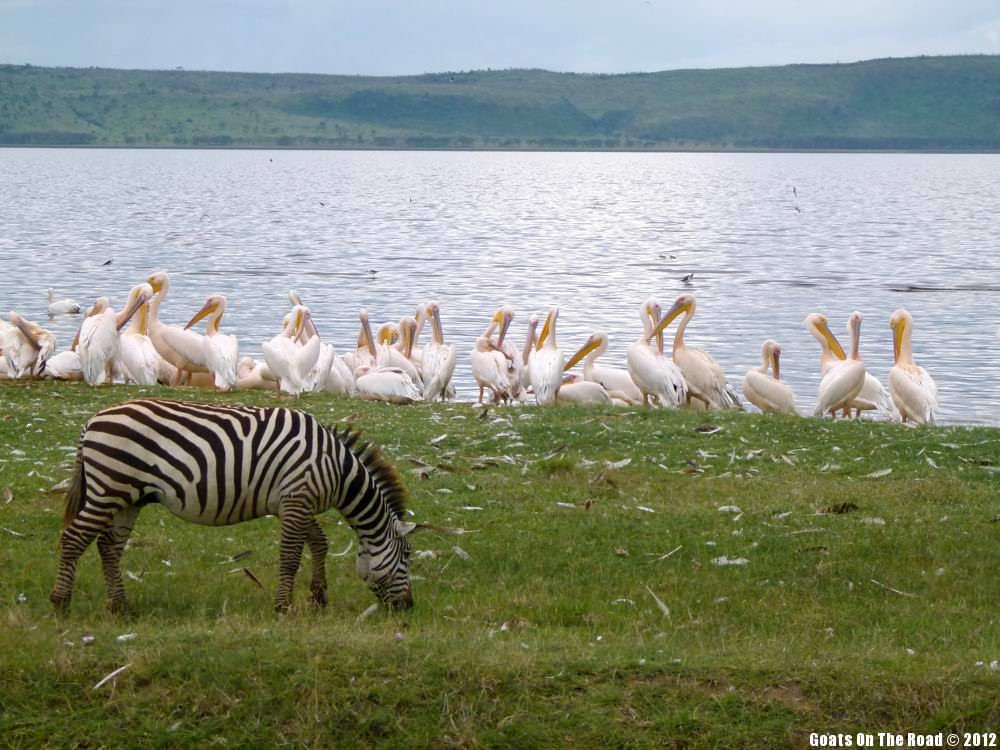
Excellent information on Kyrgyz Food Guide thanks for sharing.
I absolutely love hot black tea and I can’t think of a better way to enjoy it than while enjoying an adventure! How was it served? Special cups – like Turkey has a certain shape of glass without handles for tea… Was it flavored (like the mint tea from Morocco) or served with a sweetener? If I get the chance….tea is my all time favorite souvenir to bring back. A hot cup of tea from vacation brings wonderful memories. 😉
I read posts like this with wonderful food and wonder about my kids…one will try unusual things but the other has a really hard time with it. I wonder if we could find enough plain bread to keep them from starving on a trip like this? We might need to wait until they are a little older and receptive to the unusual like horse meat…. In the meantime, I’ll daydream with posts like this one!
Dear God do I want a fried lagman now. Thanks for that.
The dishes are interesting. Lagman and manti in particular sound delicious. Their cuisine does seem like it was heavily influenced by the Chinese.
Thank you! Yes, you really do see the Chinese and other Central Asian influences in the cuisine. It sure is good though 🙂
A lot of my friends went to Kyrgyzstan already and it made me curious. Maybe time to add this to my bucketlist
That is cool to hear! I’d highly recommend going if you have the chance.
What a great description and photos of Kyrgyz cuisine! Having grown up on a horse ranch, I can’t imagine drinking mare’s milk, but the paloo looks good.
Thank you! Yeah, the mare’s milk is something I don’t think I could ever learn to love but everything else we really enjoyed.
i never eat KYRGYZ CUISINE.
You should try it if you get a chance.
wow! that food is looking so yummy and shared so good things about it.
Thank you! It was tasty for sure.
looking so tasty food and want to eat these food soon.
Thank you! Hope you can try them soon.
Interesting post, visiting destinations and looking for delicious food is my favorite thing to do. I do want to try Kymyz and Tea with boorsoq. Thanks for sharing
Thank you! Oh good choices for things to try 🙂
Nice post! Quick question. How much do you weigh, Samuel? Haha…no need to answer! Wow…it is truly amazing to see you around so much delicious food and still not put on too much weight. The dish Paloo looks quite similar to an Indian (Mughal) dish called “Biryani”. Biryani, however, has large portions of chicken or meat.
Thank you! Um, I’m about 195 pounds at 6’1. I would like to lose 25 pounds 😉 Oh, I know what you mean about that. They are quite similar.
Wow! Looks amazing!
Thank you! It was tasty.